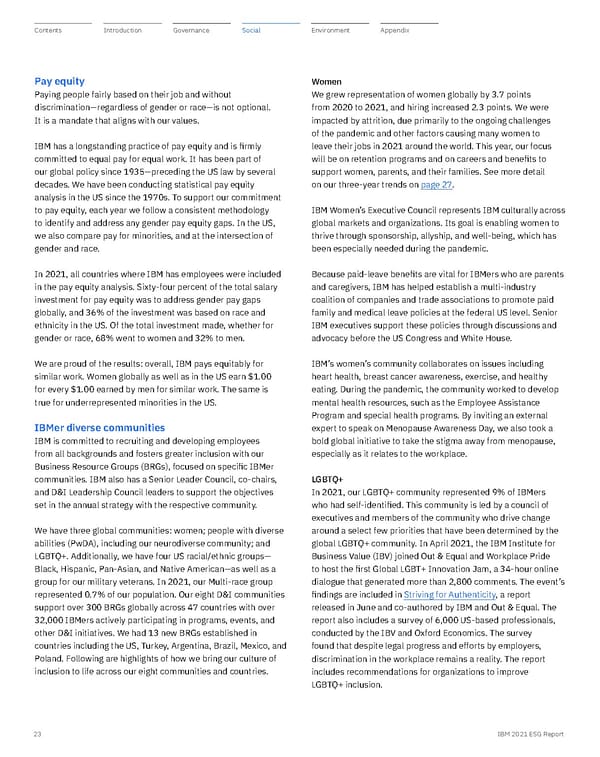Women We grew representation of women globally by 3.7 points from 2020 to 2021, and hiring increased 2.3 points. We were impacted by attrition, due primarily to the ongoing challenges of the pandemic and other factors causing many women to leave their jobs in 2021 around the world. This year, our focus will be on retention programs and on careers and benefits to support women, parents, and their families. See more detail on our three-year trends on page 27 . IBM Women’s Executive Council represents IBM culturally across global markets and organizations. Its goal is enabling women to thrive through sponsorship, allyship, and well-being, which has been especially needed during the pandemic. Because paid-leave benefits are vital for IBMers who are parents and caregivers, IBM has helped establish a multi-industry coalition of companies and trade associations to promote paid family and medical leave policies at the federal US level. Senior IBM executives support these policies through discussions and advocacy before the US Congress and White House. IBM’s women’s community collaborates on issues including heart health, breast cancer awareness, exercise, and healthy eating. During the pandemic, the community worked to develop mental health resources, such as the Employee Assistance Program and special health programs. By inviting an external expert to speak on Menopause Awareness Day, we also took a bold global initiative to take the stigma away from menopause, especially as it relates to the workplace. LGBTQ+ In 2021, our LGBTQ+ community represented 9% of IBMers who had self-identified. This community is led by a council of executives and members of the community who drive change around a select few priorities that have been determined by the global LGBTQ+ community. In April 2021, the IBM Institute for Business Value (IBV) joined Out & Equal and Workplace Pride to host the first Global LGBT+ Innovation Jam, a 34-hour online dialogue that generated more than 2,800 comments. The event’s findings are included in Striving for Authenticity , a report released in June and co-authored by IBM and Out & Equal. The report also includes a survey of 6,000 US-based professionals, conducted by the IBV and Oxford Economics. The survey found that despite legal progress and efforts by employers, discrimination in the workplace remains a reality. The report includes recommendations for organizations to improve LGBTQ+ inclusion. Pay equity Paying people fairly based on their job and without discrimination—regardless of gender or race—is not optional. It is a mandate that aligns with our values. IBM has a longstanding practice of pay equity and is firmly committed to equal pay for equal work. It has been part of our global policy since 1935—preceding the US law by several decades. We have been conducting statistical pay equity analysis in the US since the 1970s. To support our commitment to pay equity, each year we follow a consistent methodology to identify and address any gender pay equity gaps. In the US, we also compare pay for minorities, and at the intersection of gender and race. In 2021, all countries where IBM has employees were included in the pay equity analysis. Sixty-four percent of the total salary investment for pay equity was to address gender pay gaps globally, and 36% of the investment was based on race and ethnicity in the US. Of the total investment made, whether for gender or race, 68% went to women and 32% to men. We are proud of the results: overall, IBM pays equitably for similar work. Women globally as well as in the US earn $1.00 for every $1.00 earned by men for similar work. The same is true for underrepresented minorities in the US. IBMer diverse communities IBM is committed to recruiting and developing employees from all backgrounds and fosters greater inclusion with our Business Resource Groups (BRGs), focused on specific IBMer communities. IBM also has a Senior Leader Council, co-chairs, and D&I Leadership Council leaders to support the objectives set in the annual strategy with the respective community. We have three global communities: women; people with diverse abilities (PwDA), including our neurodiverse community; and LGBTQ+. Additionally, we have four US racial/ethnic groups— Black, Hispanic, Pan-Asian, and Native American—as well as a group for our military veterans. In 2021, our Multi-race group represented 0.7% of our population. Our eight D&I communities support over 300 BRGs globally across 47 countries with over 32,000 IBMers actively participating in programs, events, and other D&I initiatives. We had 13 new BRGs established in countries including the US, Turkey, Argentina, Brazil, Mexico, and Poland. Following are highlights of how we bring our culture of inclusion to life across our eight communities and countries. 23 IBM 2021 ESG Report
 ESG Report | IBM Page 22 Page 24
ESG Report | IBM Page 22 Page 24